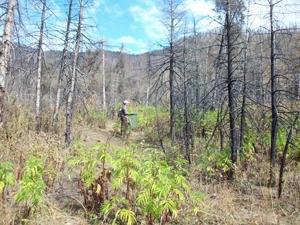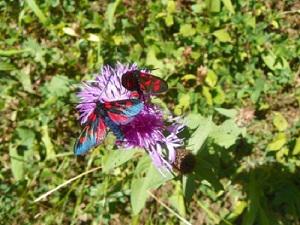Maka Murvanidze
The aim of the project is to assess an ecological situation in the forests of Borjomi protected territories by bioindicator species of insects and provide information to local people about importance of conservation of biodiversity.

Village Daba. Forest burned in 2008. First stage of succession.
The history of protected territories in Georgia dates back to the Middle Ages when this territories were used by local lords for hunting. In 1995 on the basis of Borjomi reserve, Borjomi-Kharagauli National Park was created with the support of the WWF and was officially inaugurated in 2001. The park covers more than 75,928 hectares, which amounts to nearly 1% of the territory of Georgia. In August 2008, due to Russian - Georgian military conflict, unique coniferous forests were burned, what greatly affected wildlife biodiversity.

Zygaena in Kvabikhevi reserve.
The aim of the project is to assess an ecological situation in the forests of Borjomi protected territories by bioindicator species of insects and provide information to local people about importance of conservation of biodiversity. Within the project activities, indicator species of insects (bumble bees (as pollinators), ants (as a destructors and butterflies (as exotic)) will be used for estimation of coniferous and mixed forests health. Insects are a suitable subject for assessing the impact of disturbance on ecosystem functions. They may serve as “test organisms” for comparison of disturbed and undisturbed habitats due to functional relationships between the species diversity and abundance. Knowledge about importance of sustaining biodiversity in this area is extremely low within local population.
Our project will serve as a novelty in this field as well, especially for school children, as far there are 14 public schools located on Borjomi protected territories. The results of this study will contribute in conservation management of the area. Project data will be used by the Department of Protected Territories and Borjom-Kharagauli National Park administration.
This kind of activity can serve as a basis for future long term observations on the recovery processes of biodiversity of Borjomi protected territories and can serve as a reference case study in similar ecological studies in future. Information delivered to wide society will serve as a basis for sustaining biodiversity with engagement of local population. Seminars conducted in local schools will awake interest on nature protection within students, which can be one of the most important implementation for arising future generation of nature conservationists or simply, friend of nature.